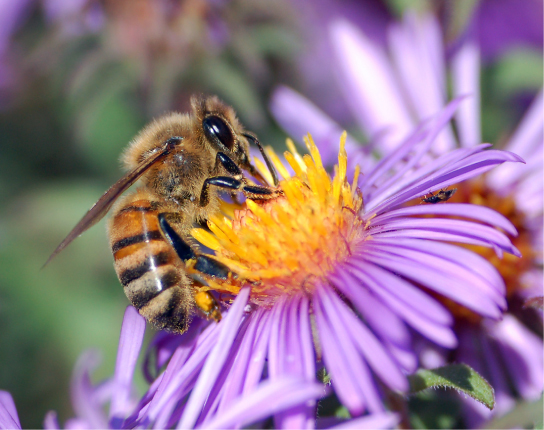26.4A: Herbivory and Pollination
- Page ID
- 13685
The diversity of plants can be attributed to pollination and herbivory, both examples of coevolution between animals and plants.
- Describe the interaction of plants and animals in achieving pollination
Key Points
- Herbivory is believed to have been as much a driving force in the evolution of plant diversity as pollination.
- Coevolution between herbivores and plants is commonly seen in nature; for example, plants have developed unique ways to fight off herbivores while, in turn, herbivores have developed specialized features to get around these defenses.
- Plants have developed unique pollination adaptations, such as the ability to capture the wind or attract specific classes of animals.
- Birds, insects, bats, lemurs, and lizards can act as pollinators; each is attracted to a specific plant adaptation, which has been developed to attract a suitable pollinator.
- Any disruption between pollinator and plant interactions, such as the extinction of a species, can lead to the collapse of an ecosystem and/or the demise of an agricultural industry.
Key Terms
- coevolution: the evolution of organisms of two or more species in which each adapts to changes in the other
- pollination: the transfer of pollen from an anther to a stigma that is carried out by insects, birds, bats, and the wind
- herbivory: the consumption of living plant tissue by animals
Animal & Plant Interactions
Angiosperm diversity is due in part to multiple interactions with animals. Herbivory has favored the development of defense mechanisms in plants and avoidance of those defense mechanisms in animals. Pollination (the transfer of pollen to a carpel) is mainly carried out by wind and animals; therefore, angiosperms have evolved numerous adaptations to capture the wind or attract specific classes of animals.
Coevolution of flowering plants and insects is a hypothesis that has received much attention and support, especially because both angiosperms and insects diversified at about the same time in the middle Mesozoic. Many authors have attributed the diversity of plants and insects to pollination and herbivory, which is the consumption of plants by insects and other animals. This is believed to have been as much a driving force as pollination.
Herbivory
Coevolution of herbivores and plant defenses is observed in nature. Unlike animals, most plants cannot outrun predators or use mimicry to hide from hungry animals. A sort of arms race exists between plants and herbivores. To “combat” herbivores, some plant seeds (such as acorn and unripened persimmon) are high in alkaloids and, therefore, unsavory to some animals. Other plants are protected by bark, although some animals have developed specialized mouth pieces to tear and chew vegetal material. Spines and thorns deter most animals, except for mammals with thick fur; some birds have specialized beaks to get past such defenses.

Herbivory has been used by seed plants for their own benefit in a display of mutualistic relationships. The dispersal of fruit by animals is the most striking example. The plant offers to the herbivore a nutritious source of food in return for spreading the plant’s genetic material to a wider area.
An extreme example of collaboration between an animal and a plant is the case of acacia trees and ants. The trees support the insects with shelter and food. In return, ants discourage herbivores, both invertebrates and vertebrates, by stinging and attacking leaf-eating organisms.
Pollination
Grasses are a successful group of flowering plants that are wind pollinated. They produce large amounts of powdery pollen carried over large distances by the wind. The flowers are small and wisp-like. Large trees such as oaks, maples, and birches are also wind pollinated.
More than 80 percent of angiosperms depend on animals for pollination: the transfer of pollen from the anther to the stigma. Consequently, plants have developed many adaptations to attract pollinators. The specificity of specialized plant structures that target animals can be very surprising. It is possible, for example, to determine the type of pollinator favored by a plant just from the flower’s characteristics. Many bird or insect-pollinated flowers secrete nectar, a sugary liquid. They also produce both fertile pollen for reproduction and sterile pollen rich in nutrients for birds and insects. Butterflies and bees can detect ultraviolet light. Flowers that attract these pollinators usually display a pattern of low ultraviolet reflectance that helps them quickly locate the flower’s center to collect nectar while being dusted with pollen. Large, red flowers with little smell and a long funnel shape are preferred by hummingbirds who have good color perception, a poor sense of smell, and need a strong perch. White flowers that open at night attract moths. Other animals (such as bats, lemurs, and lizards) can also act as pollinating agents. Any disruption to these interactions, such as the disappearance of bees as a consequence of colony collapse disorders, can lead to disaster for agricultural industries that depend heavily on pollinated crops.



